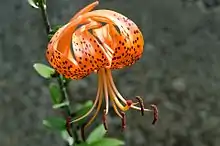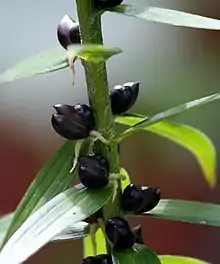Lilium lancifolium
Lilium lancifolium (syn. L. tigrinum) is an Asian species of lily, native to China, Japan, Korea, and the Russian Far East. It is widely planted as an ornamental because of its showy orange-and-black flowers, and has become naturalized in numerous scattered locations in eastern North America (particularly in New England).
| Lilium lancifolium | |
|---|---|
 | |
| Tiger Lily | |
| Scientific classification | |
| Kingdom: | Plantae |
| Clade: | Tracheophytes |
| Clade: | Angiosperms |
| Clade: | Monocots |
| Order: | Liliales |
| Family: | Liliaceae |
| Subfamily: | Lilioideae |
| Tribe: | Lilieae |
| Genus: | Lilium |
| Species: | L. lancifolium |
| Binomial name | |
| Lilium lancifolium | |
| Synonyms[1] | |
|
Synonymy
| |
It bears the proper common English name tiger lily, but that name has been applied to other species as well.
Distribution
The plant's native range covers the Russian Far East[3][lower-alpha 1] to Japan and Tibet,[1] some provinces in China, and Korea.[6][7][8] It also sporadically occurs as garden escape in North America, particularly the eastern United States,[9] and has made incursions into some southern states such as Georgia.[10]
Name
- Latin names
Botanists for many years considered L. tigrinum (after Ker Gawler[11]) the correct scientific name until it was determined that older name L. lancifolium (after Thunberg[12]) refers to the same species, and the latter became the accepted name.[9][lower-alpha 2]
- Vernacular names
Its common name is tiger lily. Although this name is ambiguous across several species, it is correctly applied to this species alone.[9]
The Japanese common name oni-yuri (鬼百合, lit. "ogre lily") is mostly now used for the L. lancifolium species.[13][14][15] The alternate name, tengai-yuri (天蓋百合, lit. "baldaquin lily"),[14] documented since at least c. 1900, with reference to the double-flowered flowered variety yae-tengai (八重天蓋),[16][17] has recurred in more recent literature.[18][19][lower-alpha 3]
One cultivar of on-yuri noted in 1900s literature is Kentan (巻丹, lit. "whorled red[?]"),[22][17][21] which is identical to the Chinese common name, 卷丹 juan dan.[13][7]
General description

Like other true lilies, the flowers are borne on upright stems that are 80–200 centimetres (31–79 in) tall and bear lanceolate leaves 6–10 centimetres (2.4–3.9 in) long and 1–2 centimetres (0.39–0.79 in) broad. Lilium lancifolium produces aerial bulblets, known as bulbils, in the leaf axils.[23] These bulbils are uncommon in Lilium species and they produce new plants that are clones of the original plant.[9]
Flowers are odorless.[23] Each flower lasts a few days and if pollinated produce capsules with many thin seeds.[9]
Varieties
.jpg.webp)
The names of names considered as varieties at some time are:
- Lilium lancifolium var. densum W.Bull
- Lilium tigrinum var. fortunei Standish
- Lilium tigrinum var. splendens Van Houtte
- Lilium tigrinum var. flore-pleno auct.
- Lilium tigrinum var. erectum G.F.Wilson
- Lilium tigrinum var. plenescens Waugh
- Lilium lancifolium var. flaviflorum Makino
- Lilium lancifolium var. fortunei (Standish) V.A.Matthews
- Lilium lancifolium var. splendens (Van Houtte) V.A.Matthews
The Lilium tigrinum flore pleno, the double-flowered variety, had been exported out of Japan by William Bull since 1869.[24]
Cultivation and uses
It is cultivated and wild foraged in Asia for its edible bulbs.[20] The cultivar 'Splendens' has gained the Royal Horticultural Society's Award of Garden Merit.[25]
Cat toxicity
A case study of the successful treatment of a cat that ingested this particular species was published 2007.[26]
Explanatory notes
- Cf. Czerepanov (1995). p. 308,[4] and Kharkevich, S.S. (ed.) (1987).[5]
- Under the rules of international botanical nomenclature, the older name takes precedence.
- An 1894 book in English fails to give tengai but instead gives "ryori-yuri" as another name for L. tigrinum.[20] But ryōri-yuri (料理百合, lit. "cooking lily") is a name for yamayuri (L. auratum) according to another reference book.[21]
References
Citations
- , World Checklist of Selected Plant Families, Kew Gardens
- Aistova, Elena (2009), "Check-list of adventive flora of Amur region" конспект адвентивной флоры амурской области, Turczaninowia, 12 (1–2): 21
- In Russian Far East, confirmed in Komsomolsk-on-Amur and Okhotia (islands? near Magadan)[2]
- Czerepanov, S.K. (1995). [https://books.google.com/books?id=52fdbx9XgC4C&pg=PA308 Vascular Plants of Russia and Adjacent States (The Former USSR): 1-516. Cambridge University Press.
- [:ru:Харкевич, Сигизмунд Семёнович |Kharkevich, S.S.] (ed.) (1987). Plantae Vasculares Orientalis Extremi Sovietici 2: 1-448. Nauka, Leningrad.
- Lim, T. K. (2014). Edible Medicinal and Non Medicinal Plants: Volume 8, Flowers. Springer Science & Business. p. 215. ISBN 978-9-401-78748-2.
- "44. Lilium tigrinum Ker Gawler, Bot. Mag. 31: t. 1237. 1809.", Flora of China 24, p. 146. 卷丹 juan dan.
- Lee, W.T. (1996). Lineamenta Florae Koreae: 1-1688. Soul T'ukpyolsi: Ak'ademi Sojok.
- "1. Lilium lancifolium Thunberg, Trans. Linn. Soc. London, Bot. 2: 333. 1794.", Flora of North America, 26, p. 178. Tiger lily, lis tigré.
- Biota of North America Program 2014 county distribution map
- Ker Gawler, J. G.; Bellenden, John (1809) "Lilium tigrinum, Tiger-spotted Chinese lily". Botanical Magazine 31: plate 1237ff.
- Thunberg, Carl Peter (1794), Transactions of the Linnean Society of London 2: 333 (in Latin)
- Wiersema, John H.; León, Blanca (1999). World Economic Plants: A Standard Reference. CRC Press. p. 405. ISBN 978-0-849-32119-1.
- Shimizu (1947), p. 55.
- Tohoku Regional Forest Office, Forestry Agency, MAFF (2016). "Angiosperms" 被子植物. Shinrin no ikimono tachi [The forests' living things]. Retrieved 2020-01-16: "鬼百合" kanji form is verified.
- Inoue, Ryūtarō (1894), Yuri kagami 百合鑑 (in Japanese), Inoue Ryūtarō, pp. 17–18
- Shin shikunshi (1901), pp. 85–86
- Makino, Tomitaro (2007), Shokubutsu chisiki 植物知識, Aozora Bunko, electronic edition based on book publ. Kodansha, 1981, 1993, originally published as Shiki no hana to kajitsu 四季の花と果実, Ministry of Communications (Japan), 1949
- Izawa, Bonjin (1894), Genshoku-ban Nihon yakuyō shokubutsu jiten 原色版日本薬用植物事典 (in Japanese), Seibundo Shinkosha, p. 271, "442 oni-yuri (tengai-yuri) (yae-tengai)",Index via NDL
- Dai Nihon Nōkai (1895). Useful Plants of Japan Described and Illustrated. Agricultural Society of Japan. p. 27.
- Shida, Gishu; Saeki, Tsunemaro; Haga, Yaichi (1909), "Yuri" ゆり【百合】, Nihon ruigo daijiten 日本類語大辞典, Kodansha, p. 1664
- It is stated that this Kentan variety's bulb presents a bitter taste (Shin shikunshi), even though the species is generally considered pleasant to eat.
- Ohwi, Jisaburo (1965), Meyer, Frederick G.; Walker, Egbert H. (eds.), Flora of Japan, Washington, D.C.: Smithsonian Institution, p. 297, archived from the original on 2010-04-23
- Moore, Thomas; Paul, William, eds. (1873), "A Beautiful Flower and Farm and Garden", The Florist and Pomologist: 15–16
- "RHS Plant Selector - Lilium lancifolium 'Splendens'". Retrieved 26 June 2013.
- Berg, Rebecca IM, Thierry Francey, and Gilad Segev (2007) "Resolution of acute kidney injury in a cat after lily (Lilium lancifolium) intoxication". Journal of Veterinary Internal Medicine 21(4), pp. 857–859.
- Bibliography
- Shimizu, Moto'o (1947). "Oni-Yuri (Lilium lancifolium Thunb.)". Lily Yearbook. North American Lily Society (7): 55–.
- Seika-en Sanjin 精花園山人 (1901), "Hana-yuri", in: Shōkadō Shujin (1901), Shin shikunshi 新四君子 (in Japanese), Tokyo Mita Ikushujyo, pp. 63–140
External links
| Wikimedia Commons has media related to Lilium lancifolium. |
